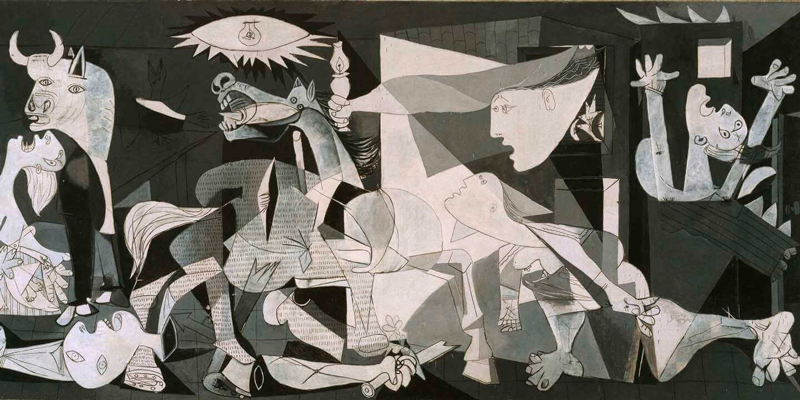
Pablo Picasso’s painting “Guernica” depicts the April 26, 1937, bombing of Guernica, a Basque Country town in northern Spain hit by Nazi Germany and Fascist Italy at the request of the Spanish Nationalists. [Pablo Picasso/Museo Reina Sofía]
War crimes investigators in Ukraine say violations of international laws and conventions by invading Russian soldiers are so grievous and widespread that they have had to limit their focus to only the worst cases.
Investigators from the non-governmental organization Truth Hounds have been documenting war crimes in the country since 2014, when Moscow annexed the Crimean Peninsula and non-uniformed Russian troops began fighting alongside Russian-speaking separatists in the Donbas region of eastern Ukraine.
Financed by private donors, endowments, governments and supporting embassies, Truth Hounds’ half-dozen field workers have conducted thousands of eyewitness interviews documenting hundreds of incidents over the past eight years.
They say the rate of violations has increased precipitously since more than 150,000 Russian troops began crossing into Ukraine on Feb. 24.
Fear was widespread that the Russians would commit war crimes, said the NGO’s Ukrainian executive director, Roman Avramenko, in an interview with Legion Magazine.
“But we didn’t expect that the number and range of crimes would be so high,” he said. “We’re well-acquainted with [the situation]. Despite this fact, we are shocked by the brutality and the scale of the crimes Russians are conducting during this invasion. It is clear to us that war crime is the way of warfare for Russia.”
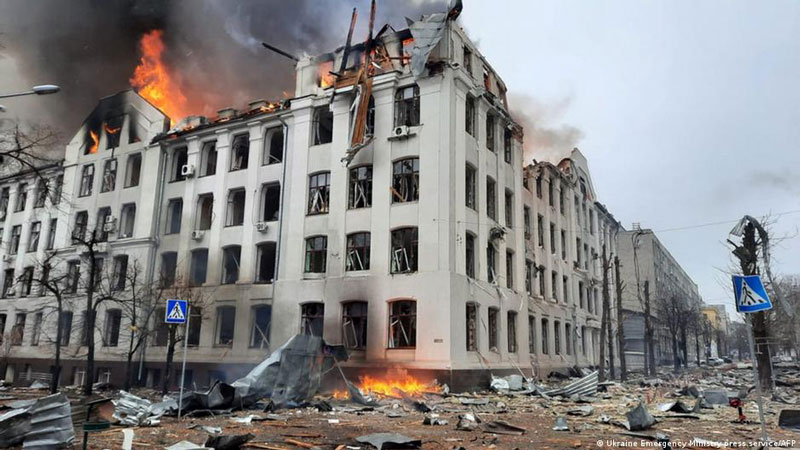
Kharkiv’s police building lies in ruin after Russian shelling. War crimes investigators say they’re shocked by the scale of Russian war crimes in Ukraine. [Ukraine Emergency Ministry Press Service]
Ukrainian Deputy Prime Minister Iryna Vereshchuk said on March 28 that Russian troops had moved 40,000 residents out of the country. A Mariupol refugee said from Russia: “All of us were taken forcibly.”
“The number of those crimes…just exploded.”
Avramenko said in some cases passports and other documents were seized and the residents shipped off by train to remote regions of Russia. “We’re not sure how these people will be able to come back without documents.”
Dmytro Koval, an associate professor and international law expert working with Truth Hounds, said war crimes had escalated since the invasion’s slow beginnings, when columns of unsupported Russian armour sat immobile for days outside Kyiv.
“We tried to document each and every war crime that was committed by Russians,” said Koval. “But after the first week, it became impossible for us to document, to report on every crime. The number of those crimes…just exploded.”
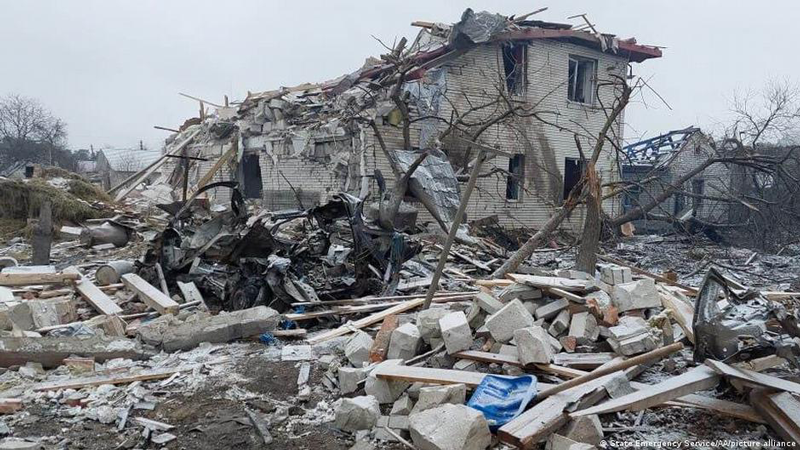
National prosecutors in Ukraine have opened more than 2,500 war crimes cases. [Ukraine Emergency Ministry Press Service]
The group decided to focus on high-casualty incidents and those involving significant damage to civilian infrastructure, along with cases where large numbers of people were put at risk as human shields and or due to environmental abuses.
Koval said the fact that Russia, with its superior numbers and equipment, has so far been unable to achieve its objectives in Ukraine has “influenced the number of crimes they are committing.”
Group investigators have documented a broad range of alleged war crimes:
- 90 per cent of cases involved shelling civilians and civilian areas, either intentionally (targeted) or indiscriminately (collateral damage);
- Russians have worn Ukrainian uniforms and patches and targeted Ukrainian civilians and military—so-called false-flag operations designed in part to undermine trust and credibility in the Ukrainian military;
- Red Cross ambulances have been used to transport weapons and equipment under the guise of medical and humanitarian aid;
- there have been at least a dozen known cases in which civilians have been used as human shields in efforts to prevent attacks on military targets;
- Russians have mounted several attacks on dams and nuclear power plants, the “most protected” infrastructure under humanitarian law;
- investigators have documented looting in some areas; in villages northwest of Kyiv, for example, Russian troops broke down every garage door, “grabbing everything they could and piling it up on their vehicles;”
- Russians have prevented food and humanitarian aid from reaching the population in Mariupol and numerous other areas, and even bombed food warehouses in apparent efforts to drive desperate populations out.
“There is basis to believe that Russia uses starvation as a method of warfare,” said Avramenko, who has conducted more than 60 field monitoring missions in Ukraine and other conflict zones.
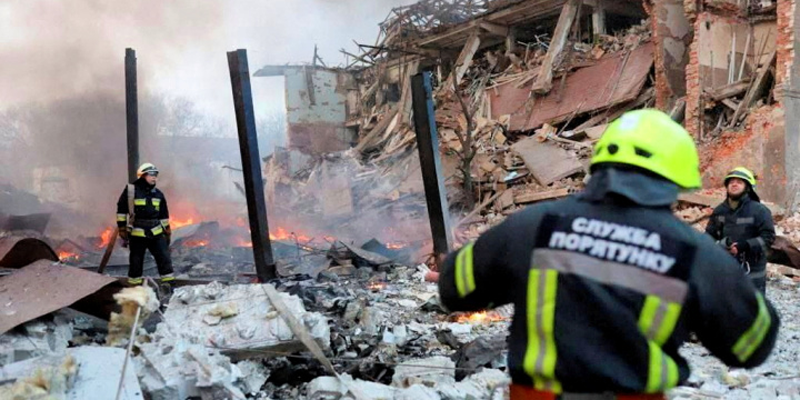
Rescue workers in the Ukrainian city of Dnipro search for survivors in the rubble of an apartment building hit by a Russian airstrike. [State Emergency Service of Ukraine]
Prime Minister Justin Trudeau condemned the killing of innocent civilians in Ukraine and said Canada remained “committed to holding the Russian regime accountable.”
“Those responsible for these egregious and appalling attacks will be brought to justice,” he said.
Avramenko said house-to-house searches and illegal detentions of civilians, including activists and elected officials, are widespread. Additionally, he suggested widely disseminated videos showing Russian tanks firing on civilian vehicles are not isolated incidents, nor are they cases of collateral damage or mistaken identity.
In some areas, “they shoot at everything that moves,” he said, noting that holes concentrated in the driver’s-side windows of vehicles prove they were targeted.
“They were aiming through the windshield at the seat of the driver,” said Avramenko. “There are many, many photos available of bullet holes, so you can clearly see this was not shelling of the territory and this can’t be counted as collateral damage, for sure.
“They saw it was a civilian car and they aimed at a civilian car with the purpose to kill civilians. Many children, many women died in these incidents across the country.”
War crimes are not necessarily as cut-and-dried as they might appear.
Distinguishing between targeted civilian infrastructure and collateral damage, however, can be difficult, though Koval said it becomes evident a hospital is being targeted when it’s hit several times. The entire city of Mariupol in eastern Ukraine has been virtually flattened.
“They continue using the same tactics, the same targeting of densely populated areas and cities,” he said. “It shows that there is a pattern of absolute ignorance of the laws and customs of war.
“These patterns and the types of weapons that are used help us to conclude that sometimes we are really speaking about war crimes.”
Still, war crimes are not necessarily as cut-and-dried as they might appear. The crimes may be evident, but tying them to a specific unit or person, much less President Vladimir Putin, and holding them to account is challenging and requires painstaking investigation and substantial evidence.
Truth Hounds is already working on a submission to the International Criminal Court in The Hague, the chief arbiter of war crimes cases to which 124 countries, including Canada, are party.
They will also make submissions to Ukraine’s national prosecution service and third-party countries who may claim universal jurisdiction over crimes committed in Ukraine. The principle provides authority to national courts to investigate and prosecute international crimes committed on foreign territory by foreign nationals.
“There are signs and signals from several jurisdictions that they are ready to pursue these types of cases,” said Koval, citing the Czech Republic, Poland, France, Switzerland and several Baltic states.
The lack of concrete action has only encouraged the Russian invasion.
No indictments have yet been handed down over the fighting in Ukraine, despite the fact it has continued for eight years. The ICC’s preliminary investigation into Russian-backed fighting in eastern Ukraine’s Donbas region took six years.
Avramenko said the lack of concrete action has only encouraged the Russian invasion and the increasing number of war crimes it has spawned.
If the international community doesn’t act now, he said, “it would be the most discouraging thing in our work.”
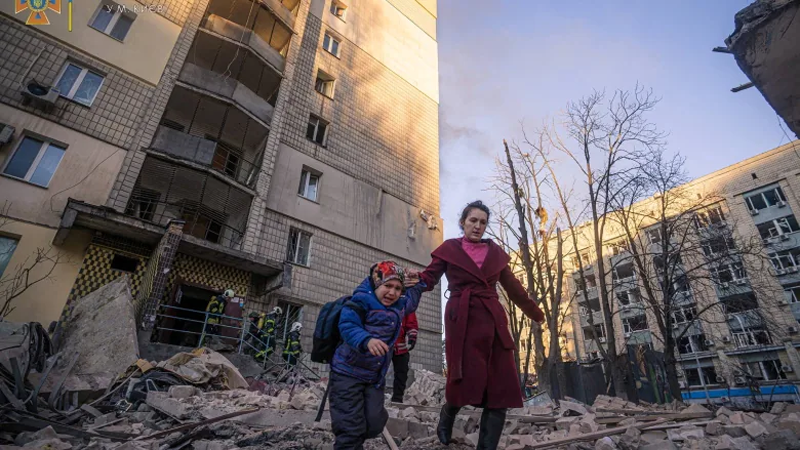
A woman and child evacuate from a residential building damaged by shelling from Russian forces in March 2022. [State Emergency Service of Ukraine]
Truth Hounds is always in need of money, investigators and equipment but, critically, Avramenko said, “we need the reaction, the strong reaction, and we need strong democracy efforts toward these issues that we document and investigate.”
That, he says, requires communications support to get their message out to decision-makers and others.
Koval is from western Ukraine; Avramenko is from the east. Both worry for relatives in occupied areas. During the interview, Avramenko was sitting in his car outside a distribution point, waiting to collect first-aid kits for his brother on the front line—and figuring out the safest route to get there.
“The human being is a beast that can accommodate any circumstances,” he said. “It takes very much of our inner resources. I am so much worried about [family] because they could be shot or the women could be raped.
“No one is talking about diapers anymore. They lack food to eat.”
Said Koval: “The work helps us distance ourselves from the reality and concentrate on the part that we can change.”
—
The Truth Hounds website can be found here; donations to help support Truth Hounds war crimes investigations may be made at the Truth Hounds Patreon page.
Advertisement





















